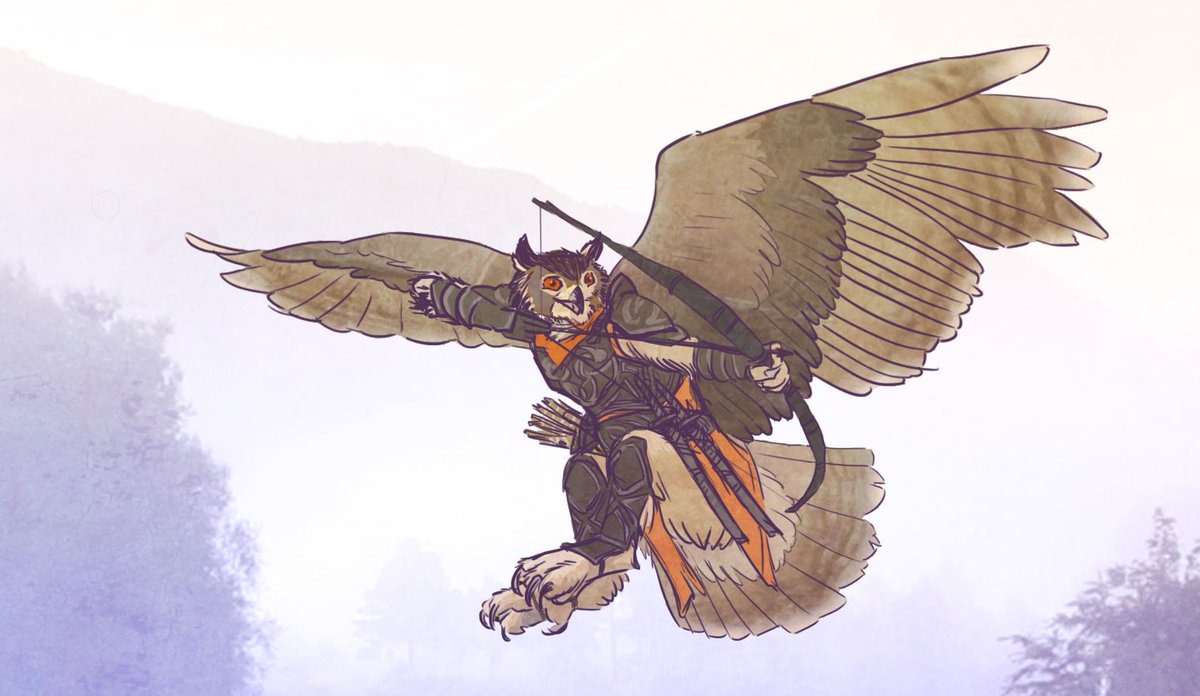Aarakocra
Sequestered in high mountains atop tall trees, the aarakocra, sometimes called birdfolk, evoke fear and wonder. Many aarakocra aren't even native to the material plane. They hail from a world beyond - from the boundless vistas of the Elemental Plane of Air. They are immigrants, refugees, scouts and explorers, their outposts functioning as footholds in a world both strange and alien.
Those who make their way to the material plane are usually outcasts or very curious.
Aarakocra as Adventurers
Aarakocra enjoy peace and solitude. Most of them have little interest in dealing with other people. For this reason, it takes an exceptional circumstances for an aarakocra to leave their tribe and undertake the adventurer's life. Neither treasure nor glory is enough to lure them from their tribes; a dire threat to their people, a mission of vengeance, or a catastrophe typically lies at the heart of the aarakocra adventurer's chosen path. Most aarakocra live on the Elemental Plane of Air. Aarakocra can be drawn into the Material Plane, sometimes to pursue enemies or thwart their foes' designs there. Accident might also send a nest of aarakocra tumbling into a world on that plane. A few find their way to such a world through portals on their own plane and establish nests in high mountains or in the canopies of old forests. Once tribes of aarakocra settle in an area, they share a hunting territory that extends across an area up to 100 miles on a side, with each tribe hunting in the lands nearest to their colony, ranging further should game become scarce.Basic Information
Anatomy
These are bird-like creatures. They can look like humanoid owls, falcons, hawks, etc. They are typically birds of prey, but a select few can look like parrots or pigeons.
Biological Traits
From below, aarakocra look much like large birds. Only when they descend to roost on a branch or walk across the ground does their humanoid appearance reveal itself. Standing upright, aarakocra might reach 5 feet tall, and they have long, narrow legs that taper to sharp talons.
Feathers cover their bodies. Their plumage typically denotes membership in a tribe. Males are brightly colored, with feathers of red, orange, or yellow. Females have more subdued colors, usually brown or gray. Their heads complete the avian appearance, being something like a parrot or eagle with distinct tribal variations.
Genetics and Reproduction
Unlike birds, this race produces offspring via live birth. The gestation period is typically 14-15 weeks.
Growth Rate & Stages
They reach maturity at age 5 and typically live to be about 16-20.
Ecology and Habitats
Elemental Plane of Air
Dietary Needs and Habits
They are scavengers above all else, but prefer a steady diet of protein and vegetables.
Biological Cycle
Aarakocra who live in the material plane find themselves shocked by the change of seasons, but they adapt after a few years.
Additional Information
Geographic Origin and Distribution
Aarakocra typically live in tribes. Originally from the Elemental Plane of Air, those that have settled in the material plane have become acclimated to whatever climate they find themselves in over generations. For this reason, Aarakocra can live just about anywhere, though most settle in higher elevations.
Perception and Sensory Capabilities
They have heightened hearing and sight and can fly.
Civilization and Culture
Naming Traditions
As with much of their speech, aarakocra names include clicks, trills, and whistles to the point that other peoples have a difficult time pronouncing them. Typically, a name has two to four syllables with the sounds acting as connectors. When interacting with other races, aarakocra may use nicknames gained from people they meet or shortened forms of their full names.
An aarakocra of either gender may have one of these short names: Aera, Aial, Aur, Deekek, Errk, Heehk, Ikki, Kleeck, Oorr, Ouss, Quaf, Quierk, Salleek, Urreek, or Zeed.
Culture and Cultural Heritage
The resemblance of aarakocra to birds isn’t limited to physical features. Aarakocra display many of the same mannerisms as ordinary birds. They are fastidious about their plumage, frequently tending their feathers, cleaning and scratching away any tiny passengers they might have picked up. When they deign to descend from the sky, they often do so near pools where they can catch fish and bathe themselves.
Many aarakocra punctuate their speech with chirps, sounds they use to convey emphasis and to shade meaning, much as a human might through facial expressions and gestures. An aarakocra might become frustrated with people who fail to pick up on the nuances; an aarakocra’s threat might be taken as a jest and vice versa.
The idea of ownership baffles most aarakocra. After all, who owns the sky? Even when explained to them, they initially find the notion of ownership mystifying. As a result, aarakocra who have little interaction with other people might be a nuisance as they drop from the sky to snatch livestock or plunder harvests for fruits and grains. Shiny, glittering objects catch their eyes.
They find it hard not to pluck the treasure and bring it back to their settlement to beautify it. An aarakocra who spends years among other races can learn to inhibit these impulses.
Confinement terrifies the aarakocra. To be grounded, trapped underground, or imprisoned by the cold, unyielding earth is a torment few aarakocra can withstand. Even when perched on a high branch or at rest in their mountaintop homes, they appear alert, with eyes moving and bodies ready to take flight.
Origin/Ancestry
Avian
Lifespan
30 Years
Average Height
6' 0"
Average Weight
140 lbs
Geographic Distribution



